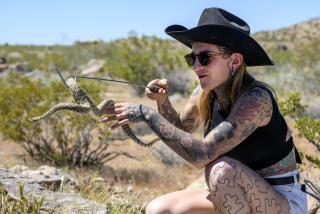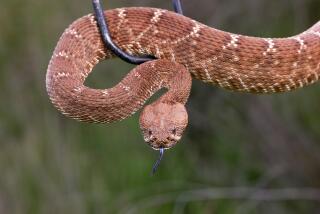Snakes, and the People Who Love Them
On the morning of July 10, 1966, I arrived at the dining room table in our Tustin house for my usual breakfast of Frosted Flakes. Mom was there, standing in the kitchen, eyeing me with feigned nonchalance. I figured I was probably in some kind of trouble again, a not uncommon state for this 12-year-old. Reviewing quickly the events of the day before, I came up with nothing for which I was about to be punished, sat down confidently and viewed the front page of the newspaper that Mom had placed next to my cereal bowl.
The story began:
8-Foot Cobra Strikes;
Bite Fatal to Countian
SANTA ANA--A bite by an 8-foot pet cobra Sunday night proved fatal for Wesley Dickinson, 45, a lifelong herpetologist, ...
I looked at the picture of Mr. Dickinson, which accompanied the sidebar story. I read the headline again. I felt touched by something large, final, unfamiliar but eerily proximate.
“Mom, Wes died.”
“I know.”
“Wow. He was fine the last time I saw him.”
“He had six cobras in his house.”
“They were friendly.”
“One wasn’t.”
“What’s a countain?”
“Coun tian. Someone who lives in this county.”
“I can’t believe he’s dead.”
“It’s really too bad. I know you liked him.”
I didn’t know Wes Dickinson well at all. I’d seen him at the Southwest Herpetology Society meeting that used to be held in a mortuary building beneath a water tower in Garden Grove, then later at Lincoln Savings on 17th Street in Santa Ana.
At that time, the society was a loose-knit bunch of snake and lizard enthusiasts who showed up once a month with whatever they’d caught on their latest snake hunts. The meeting room frothed with reptiles--jars and bags and boxes and handfuls of them, slithering through the outstretched arms of proud owners, wrapped around necks and shoulders, eyes alert and tongues flashing, escaping occasionally to slide across the linoleum floor and make a beeline for freedom.
Into this den of eccentricity each month strode Wes Dickinson, a man with quiet, patriarchal bearing and little interest in the common catch that my friends and I had so laboriously removed from the local hills, mountains, deserts.
Wes had an imperial air that came not from himself but from the awe with which we beheld him. His left arm was twisted and shrunken, because a rattlesnake had bitten him. Wes was an expert in cobras. Wes was not afraid of them at all. Wes had been all over the world, catching snakes. Wes was totally bitchin’.
Just a few weeks before his death, Wes had been the guest speaker for our meeting. As 50 of us sat spellbound in the mortuary building, Wes went to the podium carrying a large sack. From the sack he brought his prize possession: a 14-foot king cobra. He didn’t grab it behind the head or use a snakestick, he just pulled the arm-thick serpent from the bag and, using three eager volunteers from the audience, displayed to the astonished membership this majestic, lethal animal.
As the cobra’s big blunt head explored Wes’ hands, arms, torso, face, I kept in mind the extremely interesting thought that if it bit him, Wes would probably die before we got him out the door. Not that I wanted that to happen, but any moment so pregnant with the possibility of disaster is just what it takes to capture a 12-year-old’s attention.
I sat mesmerized by the size and danger of the thing, by Wes’ mastery of it. Wes proceeded to force-feed the snake, an operation involving dead rats and knitting needles. By classical aesthetic standards this was not a pretty sight. I loved it.
It is more or less obvious that snake enthusiasts are usually very weird guys and an occasional equally weird gal. In fact, it can be successfully argued that the enthusiasts are even more colorful, mysterious and bizarre than the snakes they tote around or travel the world to find. There was a pantheon of oddballs in the Southwest Herpetology Society back then, many of whom I remember with perfect clarity. I include myself in the spirit, if not the status, of these people, just to show that I mean no offense.
What is the allure of the serpent?
Shine, silence, symmetry, calm, color, quickness, patience, pattern, simplicity, grace, danger and of course our collective belief--on at least some level--that the serpent was the embodiment of the devil and thus remains today the ultimate minority, an outcast to be feared, loathed, avoided, killed. It’s hard to find an animal that carries for us more atavistic freight than a snake. Sharks, maybe, or big cats.
Lastly, the charm of the present-day reptile is that a person can hold in his or her hand a miniature version of the great dinosaurs. (Dinosaurs were reptiles, not birds--a truth apparent to all but the most pointy-headed scientists.) A casual glance at the attendance figures for the film “Jurassic Park” or a visit to almost any pet store, where reptiles are currently quite a rage, will remove any doubt that people just flat out like reptiles, big or small--anything that smacks of those pure, prehistoric days before smog, rap, televangelists.
I stopped attending the herpetology meetings many years ago and reduced my forays into the wild to catch snakes. Girls, baseball, bodysurfing, college and career all took me further and further away from the allure of the serpent.
Recently, however, I did go to the Reptile Expo at the Orange County Fairgrounds. It was pleasantly shocking to see how much the theory and practice of amateur herpetology has changed in the past 10 years. Gone are the days of collecting wild snakes. Almost every reptile at this show--there were thousands--was bred in captivity.
These home-grown specimens are astonishingly beautiful, the result of careful breeding to enhance color and pattern. Most of them were just hatchlings, because snakes eggs hatch in late summer. All were sexed so that the buyer could get a male and a female and breed up a batch should the urge for a houseful of tiny dinosaurs strike. Prices were reasonable.
It was great to look out over this squirming sea of newly hatched snakes and realize that none was taken out of its home in the desert or woods, that many were destined for enthused collectors or perhaps for release into the wilds. I was tempted to buy a hundred, but didn’t.
It was great to realize, too, that the old human capacity for embracing the weird, the disreputable, the odd, the helpless, the scorned, is still out there, maybe even growing.
It was distressing, though, to read last week of the two Orange County men (and 12 others) arrested for suspected illegal reptile trafficking. From what some of the suspects said, and from pictures taken in their homes, it seemed likely to me that these people were serious hobbyists who were captive breeding some native California snakes--which is legal.
As well as California’s Department of Fish and Game has managed diminishing resources in the most populous state in the nation, it struck me that the man hours and money spent in rounding up these “traffickers” could well have been better applied elsewhere. The main concern of one suspect was telling: He hoped that his confiscated snakes wouldn’t be housed under conditions that would kill them.
Reading about these hobbyists reminded me of Wes Dickinson and the fringe enthusiasts of the early days. The allure of the reptile hasn’t diminished a bit, but the methods of procurement have certainly improved. It takes a special kind of person to raise a snake, or to die for one.
More to Read
Sign up for Essential California
The most important California stories and recommendations in your inbox every morning.
You may occasionally receive promotional content from the Los Angeles Times.










